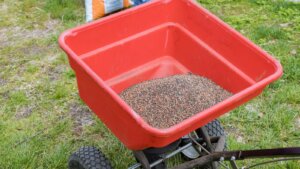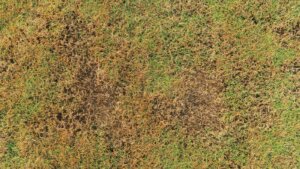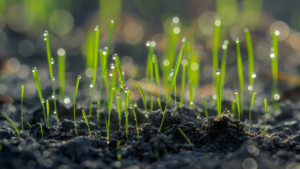Are you tired of watching birds turn your laboriously sown new grass seed into their next meal? If so, you’re not alone. Many homeowners are on a quest to learn how to stop birds from eating grass seed, aiming for a lush, vibrant lawn without unwanted avian interference. Birds, though integral to our ecosystem, can thwart your lawn cultivation efforts, especially when they descend in flocks, driven by hunger, to feast on your newly sown grass. This guide is your comprehensive resource for strategies that help keep birds away from your grass seed, ensuring your new grass gets the robust start it deserves.
Discover Effective Strategies
- Understanding Bird Attraction: Grasp why your lawn, especially with new grass seed, becomes a magnet for birds, including pigeons and other hungry birds.
- Innovative Protection Methods: Uncover the ways to keep birds from your grass seed, focusing on:
- Netting: A reliable way to stop birds by creating a physical barrier.
- Bird Deterrents: Techniques involving reflective objects, bird of prey decoys, and auditory scares to keep the birds at bay.
- Cultivation and Maintenance: Learn the best practices for sowing new grass seed and maintaining your lawn to naturally deter birds.
Armed with the knowledge from this guide, you’ll not only find out how to stop birds from eating your grass seed but also discover the best way to keep your lawn thriving and bird-free. Whether you’re battling pigeons or trying to outsmart other bird species that love to feast on your grass seeds, this article offers the insights you need. Let’s dive into the details and ensure your efforts in cultivating a new lawn are not in vain, but instead lead to the growth of a beautiful, bird-resistant green space.
Seed: The Foundation of a Lush Lawn
Grass seed is the cornerstone of a healthy, green lawn. However, once sown, these seeds become a prime target for birds. To safeguard your seeds, it’s crucial to understand why birds are attracted to them and how to make your lawn less appealing. Birds are drawn to open areas where seeds are easily accessible. By making your grass seed less accessible or less attractive, you can significantly reduce bird interference.
- Cover the Seeds: Utilizing mulch or a fine layer of soil can hide the seeds from birds. Ensure the cover is light enough to not impede germination.
- Sow at the Right Depth: Planting grass seed at the recommended depth not only aids in proper germination but also makes it harder for birds to find.
Grass Seed: Protecting Your Investment
Protecting your grass seed from birds is an investment in your property’s aesthetic and value. There are several methods to prevent birds from feasting on your newly sown grass, each varying in approach but unified in their goal: to keep your seeds safe until they can sprout into a new lawn.
- Netting: Placing a fine mesh net over the seeded area can physically block birds from accessing the seeds while still allowing sunlight and water to penetrate.
- Bird Deterrents: Objects that move, reflect light or mimic predators can deter birds. Consider installing reflective tapes, fake owls, or even wind chimes to frighten birds away.
Grass: Cultivating Your New Lawn
The journey from seed to lawn is a critical period for grass seed. Birds attracted to the easy meal your sown seed represents, can disrupt this process. To cultivate a new lawn successfully, consider integrating bird-resistant grass varieties or taller grass types that are less appealing to birds.
- Choose Bird-Resistant Varieties: Some grass types are less attractive to birds. Research and buy grass seed blends designed to be less appealing.
- Maintain Growth: Once your grass starts to grow, keep it at a slightly taller height to discourage birds from landing and feeding.
Eating Grass: Understanding Bird Behavior
To effectively keep birds from eating your grass seed, it’s helpful to understand their behavior. Birds eat grass seed because it’s a readily available food source. By altering your lawn’s appeal or accessibility, you can discourage birds from visiting.
- Feeders Away from the Lawn: Installing bird feeders at the periphery of your property can attract birds away from the seeded areas.
- Water Sources: Similarly, providing water sources away from the lawn can draw birds elsewhere.
Net: A Physical Barrier
Netting stands out as one of the most effective physical barriers against birds. It directly prevents birds from reaching the grass seeds without harming them. Ensure the net is securely anchored and checked regularly to prevent birds from becoming trapped.
- Installation Tips: Keep the net a few inches above the ground to allow grass to grow freely.
- Removal Timing: Remove the netting once the grass has germinated and reached a height where birds are less likely to cause damage.
Preventing Birds from Eating: Alternative Strategies
Beyond physical barriers, there are creative and alternative strategies to keep birds from eating your grass seed. From changing the timing of your sowing to using decoys, these methods can be highly effective.
- Timing: Birds are most active during early morning and late afternoon. Sowing seeds outside these times can reduce visibility to birds.
- Decoys and Distractions: Use decoys to create a sense of danger for birds or distractions to lure them away from the seeded area.
Deterrent: Stopping Birds Eat Grass Seed
Bird deterrents range from visual scares to auditory devices designed to keep birds away. The key is variability; changing deterrents regularly prevents birds from becoming accustomed to them.
- Auditory Deterrents: Devices that emit predator calls or distress signals can be effective but should be used considerately to avoid disturbing neighbors.
- Visual Scares: Moving objects, such as CDs or tin foil strips, can reflect light and move with the wind, creating an environment that birds avoid.
Mulch: A Dual-Purpose Solution
Mulch not only helps retain moisture and regulate soil temperature, aiding in seed germination, but it can also act as a physical barrier against birds. A thin layer of straw mulch can obscure seeds from view while supporting optimal growing conditions.
- Application: Apply a light layer of straw mulch immediately after sowing the seeds.
- Benefits: Besides deterring birds, mulch helps maintain soil moisture, crucial for seed germination.
Bird Feeder: A Distraction Technique
Positioning bird feeders away from your newly seeded lawn can serve as an effective distraction. By providing an alternative food source, you can keep birds satisfied and away from your grass seed.
- Strategic Placement: Locate feeders at the edges of your property, far from the seeded area.
- Variety of Seeds: Offering a variety of seeds that birds prefer can make the feeder more attractive than your grass seed.
Incorporating these strategies can significantly reduce the likelihood of birds eating your grass seed, paving the way for a lush, healthy lawn. While these methods are effective, consulting with a professional lawn care service can provide tailored solutions and peace of mind during this critical phase of lawn establishment. Remember, patience and persistence are key to protecting your grass seed and achieving the lawn of your dreams.



